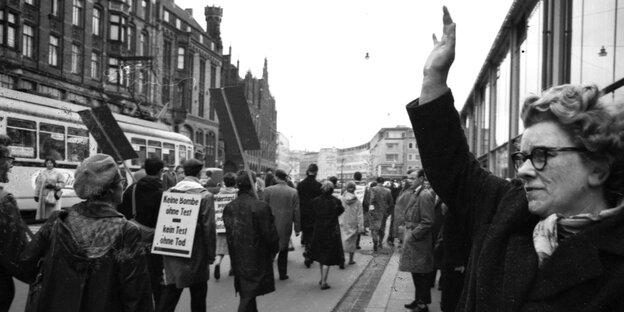During Holy Week, around 100 Easter marches have been announced. Sometimes dozens are expected, sometimes thousands. About what remains of a movement.

The first Easter march against nuclear weapons on German soil with 300 participants on April 17, 1960, from Hanover to Bergen-Hohne Photo: Klaus Rose/Picture Alliance
War against Ukraine, war in Gaza: this year's peace movement's Easter marches are dominated by conflicts in Eastern Europe and the Middle East. Organizers demand an end to the killings, a ceasefire and negotiations. Around 100 demonstrations, rallies and vigils have been announced across the country. The Bonn-based network of peace cooperatives expects “active participation.” In reality, this means that in some places a few hundred people will take to the streets, while in other places only a few dozen people will take to the streets. They are the remains of a movement that, in the best of cases, was capable of mobilizing hundreds of thousands of people.
Good Friday 1958. More than 10,000 people gather in London to protest against the British nuclear weapons programme. Their demonstration lasts four days and takes them more than 80 kilometers to the “Atomic Weapons Establishment” in the southern English town of Adlermaston, where nuclear bombs are being developed. Images of the demonstration go around the world, the Adlermaston March becomes a beacon for the international Easter March movement.
In the Federal Republic of Germany, the first Easter march, with around 1,500 participants, took place in 1960 at the Bergen-Hohne military training area in the Lüneburg Heath. NATO has stationed Honest John missiles there. They are supposed to contain nuclear warheads. Inspired by student protests, Easter protesters gained enormous popularity in the second half of the 1960s. In 1967, 150,000 protesters participated in Easter campaigns in more than 200 cities; a year later they were double that.
Easter march songs also spread in the GDR
In those years, the Easter march songs also spread across the Wall and the German-German border. Members of the young GDR singing movement also spread the melodies as they were, sometimes slightly rewritten and with criticism of the Warsaw Pact weaponry.
In West Germany, the movement is falling apart: disputes are mainly sparked by the fact that the German Communist Party (DKP) and its “mass organizations” justify the invasion of Czechoslovakia by Warsaw Pact troops. The Easter marches experienced a revival around 1980 with the debate over arming NATO with medium-range nuclear weapons; Tens of thousands gathered at sites planned for cruise missiles and Pershing II rockets. The wars in Yugoslavia and Iraq mobilized numerous people in the 1990s and 2000s. After that, the number of Easter protesters stabilized at a few thousand.
This year, in addition to the wars in Ukraine and Gaza, which are also present in the media, the issue of weapons in the conventional and nuclear sectors is also topical. The call for a world free of nuclear weapons will be heard in many speeches and will provide “a clear counterpoint” to calls for increased arms and a European nuclear deterrent, according to the call for the Easter march of the Cooperative Network for Peace. The demand that Germany once again be “ready for war” must be “resolutely opposed”: “Germany must support diplomatic initiatives in wars and not spend millions on weapons. In other words: Germany must “orient itself towards peace”!”
“Our call for the Easter March was signed this year by more than 2,000 people and 71 organizations,” says the network's spokesperson, Kristian Golla. “People want the federal government to finally become more active in ending wars at the negotiating table.” The Easter March headquarters in Frankfurt am Main also rejects the “unspeakable demand that Germany be capable of waging war” in its appeal.
Civil nuclear energy and air base in sight
“Scenarios of preparing for war through the construction of nuclear bunkers, the expansion of war research, the presence of soldiers in schools and the introduction of compulsory military service are also rejected,” said spokesman Willi van Ooyen. However, the calls do not include whether weapons should be delivered to Ukraine until possible negotiations.
As in previous years, the Easter protesters in Potsdam were the first to take to the streets. About 200 people demonstrated there on March 23. Most events take place over the Easter weekend, including the traditional three-day Rhine-Ruhr Easter March from Duisburg to Dortmund, as well as Easter marches in most state capitals. .
Local alliances establish their own themes. In Jagel, Schleswig-Holstein, protesters want to go to the Air Force air base, and in Unterlüß, Lower Saxony, to the Rheinmetall arms factory. At the uranium enrichment plant in Gronau, Westphalia, Easter protesters also target civil nuclear energy.
In many places, union and church members have been announced as speakers at the rally. In some cases, the organizers also include prominent representatives of the left or the Sahara Wagenknecht Alliance. Otherwise, as far as can be seen, friends of Russia and activists from both fronts are not among the guests. As is well known, the online petition “Peace Manifesto” started by Wagenknecht and Alice Schwarzer in February 2023 and the large demonstration on February 25 in front of the Brandenburg Gate united participants from the far left to the far right. .